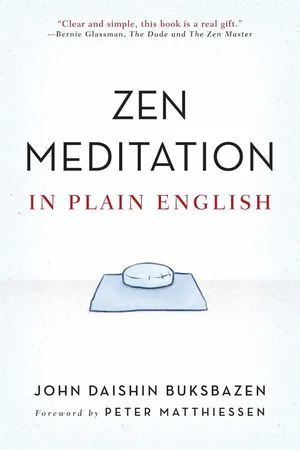
This is a test
- 128 pages
- English
- ePUB (mobile friendly)
- Available on iOS & Android
eBook - ePub
Zen Meditation in Plain English
Book details
Book preview
Table of contents
Citations
About This Book
An excellent, practical introduction to Zen meditation. Written in a warm and easily accessible style, this book appeals to anyone with an interest in meditation, Zen, or, as is often the case today, a combination of the two. The book emphasizes the importance of receiving good instruction and of finding groups to practice with, yet it lays out the necessary steps to practice Zen meditation on your own. The book includes easily followed exercises to help the reader along. For anyone looking to uncover a clear and insightful path into the philosophy and practice of Zen meditation, this book represents the culmination of that search.
Frequently asked questions
At the moment all of our mobile-responsive ePub books are available to download via the app. Most of our PDFs are also available to download and we're working on making the final remaining ones downloadable now. Learn more here.
Both plans give you full access to the library and all of Perlego’s features. The only differences are the price and subscription period: With the annual plan you’ll save around 30% compared to 12 months on the monthly plan.
We are an online textbook subscription service, where you can get access to an entire online library for less than the price of a single book per month. With over 1 million books across 1000+ topics, we’ve got you covered! Learn more here.
Look out for the read-aloud symbol on your next book to see if you can listen to it. The read-aloud tool reads text aloud for you, highlighting the text as it is being read. You can pause it, speed it up and slow it down. Learn more here.
Yes, you can access Zen Meditation in Plain English by John Daishin Buksbazen in PDF and/or ePUB format, as well as other popular books in Theology & Religion & Buddhism. We have over one million books available in our catalogue for you to explore.
Information
Topic
Theology & ReligionSubtopic
BuddhismPART ONE:
BUDDHAS

BACKGROUND
THE STORY OF SHAKYAMUNI BUDDHA
ABOUT TWENTY-FIVE hundred years ago in India, the son of a wealthy and powerful nobleman made a profound discovery. Dissatisfied with his sheltered existence, and deeply troubled by the problems of life and death and the human suffering all around him, he left his family compound and set off upon a journey of self-exploration and study. And after many years of rigorous asceticism and scholarly philosophical research, he still had to admit that he was unable to answer a fundamental question: “What is life-and-death all about?”
At that point, he abandoned his previous practices of fasting, self-mortification, and intellectual inquiry. He decided that the only way for him to really grapple with that question was to grapple directly with himself.
So he stopped fasting, bathed himself, had a bowl of milk (which really shocked his fellow ascetics!), and looked for the answer within. For six years, we are told, his main activity was sitting motionless hour after hour, looking deeply into his own mind. Now he knew he was on the right track; he could feel it as he grew steadier and stronger in his meditation. But even though he was determined, it still took a lot of hard work for him not to become discouraged and not to wander off into some other activity.
But he kept at it steadily and one day sensed that he was reaching a crisis. He simply had to break through whatever it was that separated him from realization of the Truth. And so it was, in that frame of mind, that he sat down under a tree and vowed to not rise until he had either answered his burning question or died in the attempt.
Sitting there, he focused his whole attention upon that question and became so absorbed in his consuming inquiry that he lost track of everything else. He didn’t even think of himself or about the nature of the question; he was too busy questioning. He and the question no longer seemed to be two different things. It was as though he had totally become one with the question, had become the questioning itself.
On the morning of December the eighth, as he sat there in deep meditation, he caught a glimpse of the morning star—the planet Venus—alone in the empty sky at dawn. And at that moment, something tremendous happened. He suddenly was that morning star, suddenly was the whole universe itself. Of course, this experience could have been precipitated by almost anything else: a chirping bird, a passing dog, a stubbed toe. In fact, almost any phenomenon could have triggered his breakthrough once he had become sufficiently concentrated and focused upon his question. But in the case of the man called Siddhartha Gotama Shakyamuni, the stimulus was seeing the planet Venus. At that point, his question vanished, and he knew. It was as though he had suddenly awakened from a dream and was able to see reality directly for the first time.
And from then on, people called him Buddha, which simply means “The One Who Woke Up.”

We must see our life clearly.
The existence of this very moment—
what is it?
Maezumi Roshi

THE LINEAGE
The Buddha spent the rest of his life, nearly fifty years more, telling and showing people how they too could wake up by making the same discovery he had made. Gradually others came to practice sitting in meditation as he had taught it and found for themselves the experience of realizing who they truly were and what life and death were about on the most fundamental level.
Through the years following his breakthrough, many of his followers made the same discovery. But it was not until late in his teaching career that the Buddha was satisfied that one of his disciples had really deepened and clarified his understanding sufficiently to carry on the teaching independently. Once he had found this person, a man named Mahakashyapa, the Buddha publicly named him as the successor to his own understanding, to his own state of mind.
This man, Mahakashyapa, in turn waited until he too could confidently name one of his disciples as successor, able to provide fully reliable instruction and guidance to future students.
And so it went, each successor in turn training many students and always looking for one or more of them who would have a deep and clear enough understanding and the right personal qualities to carry on the teaching.
This went on for twenty-eight generations in India, before one of these successors, Bodhidharma, finally found his way to China, bringing with him the practice of sitting. After six generations in China, the teaching spread to Korea, the rest of Asia, and eventually to Japan. What’s most important to keep in mind about this continuation of the teachings is that it was never based upon purely intellectual study or secondhand understanding; always the individuals who were entrusted with the responsibility to transmit Buddhism properly were those whose practice and realization were outstanding, and who had thoroughly grasped the essence of each phase of the teaching. Additionally, the personality of the individual must be especially suited to the task of teaching others. With these conditions satisfied, the person could then become a successor in the teaching lineage of his or her teacher.
It is this unbroken line of teachers and their successors that has helped ensure that the enlightenment of the historical Buddha has continued through more than eighty generations from India through China to Japan and now to the Western world.
It is essential that one practice under the guidance of an authentic representative of this succession if one wishes to attain to a deep and clear understanding of life and death.

No one can live your life except you.
No one can live my life except me.
You are responsible. I am responsible.
But what is our life? What is our death?
Maezumi Roshi

BUDDHAS IN AMERICA
That Zen has been transmitted across culture and continents reminds us that Buddhism is not some alien Oriental mystery that we as Westerners cannot understand. It has come to us from Asia, but the point is that we here in the West can now participate in this practice, not as foreigners dipping into an unfamiliar culture, but in our own right, as ourselves, dipping into ourselves. When this takes place, Buddhism is as natural and indigenous to the West as are those who practice it.
Today, as much as anyone ever before, we are concerned with the kinds of questions the Buddha was asking. We seem to be searching for some basic principle to tie everything together. We want this principle to be something that helps us to live and to grow harmoniously and sanely in an increasingly difficult world.
Being of a practical turn of mind, we don’t want to settle for concepts alone, for vague emotional generalities, or to accept secondhand the insights of somebody else, no matter how revered or respected that other person might be. We want to find out for ourselves, directly, clearly, and without doubt, just who we are, what our life is, and exactly what difference that clarity makes.
In the day-to-day, month-to-month, year-to-year practice with a teacher who embodies that realization we find the inspiration and guidance that the students of Buddhism have always sought from and found in their teachers. And after the kind of training and realization that repeated contact with a teacher offers, the student ultimately is able to take enlightenment itself as teacher and guide, having discovered who he or she really is, having forgotten the narrow self.
dp n="28" folio="27" ?Shakyamuni Buddha urged his students not to depend upon others, but to look to themselves for liberation. Seventeen centuries later, the great Japanese Zen master Dogen taught:
To study the Buddha way is to study the self.
To study the self is to forget the self.
To forget the self is to be enlightened by the myriad things.
Here, in these pages, is how to get started doing just that.

Zazen is the practice and realization
of manifesting our body as bodhi, as enlightenment.
It is both the practice and the realization, for when we truly do zazen,
there is no distinction between practice and realizatio...
Table of contents
- Cover
- Praise
- Dedication
- Acknowledgements
- Foreword
- Introduction
- PART ONE: BUDDHAS
- PART TWO: SITTING
- PART THREE: COMMUNITY
- Afterword
- Frequently Asked Questions
- Appendices
- About the Author
- About Wisdom
- Copyright